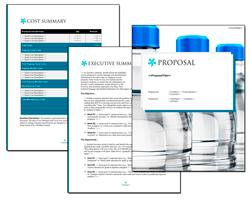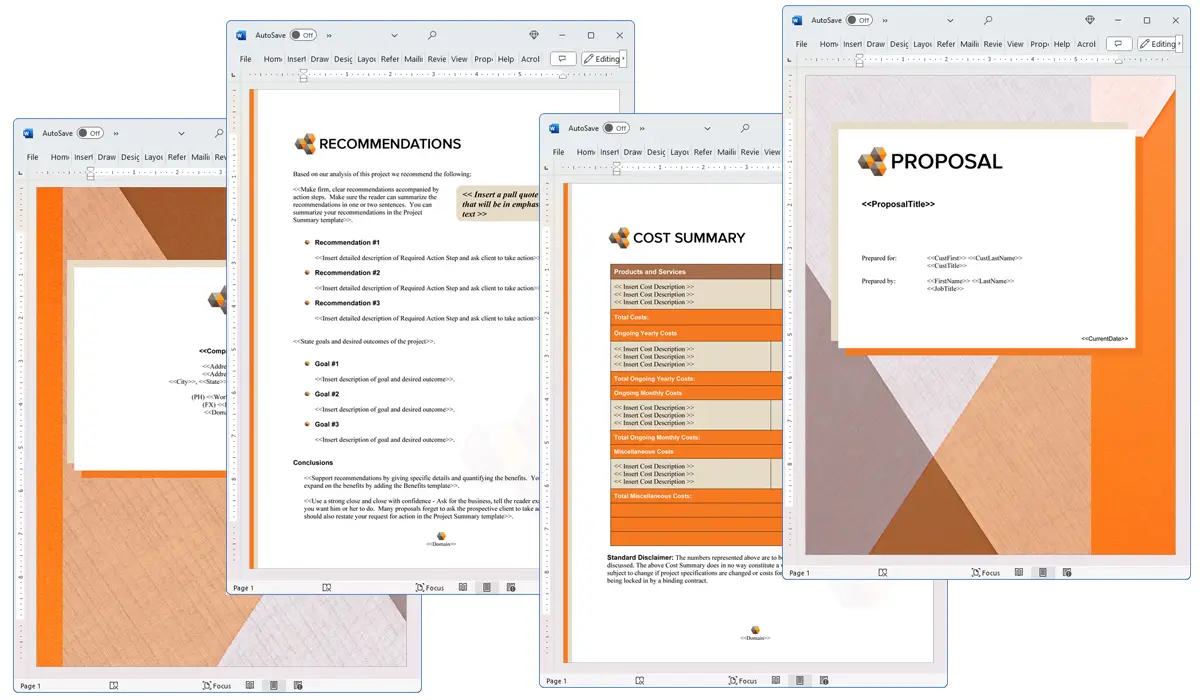What is the Return on Assets chapter used for?
Proposal Kit Professional Bundle adds more design themes, all six Contract Packs,
a project management library, and Expert Edition software.

Illustration of Proposal Pack Wireless #4
We include this Return on Assets chapter template in every Proposal Pack, along with thousands more. You assemble this chapter with others in various combinations to create custom-tailored business proposals, plans, reports, and other documents. Proposal Packs apply custom visual designs to the templates, giving the final documents a consistent professional finish.
 DOWNLOADABLE, ONE-TIME COST, NO SUBSCRIPTION FEES
DOWNLOADABLE, ONE-TIME COST, NO SUBSCRIPTION FEES
Overview of the Return on Assets Chapter
The Return on Assets chapter is an important part of many business proposals, particularly when the goal is to secure funding or demonstrate the financial health of a company. This chapter provides a detailed account of how a company is using its assets to generate earnings. The assets could range from cash and inventory to more static investments like real estate and equipment. In a proposal, this chapter helps show potential investors or partners the profitability of the assets relative to the investment, giving them a clearer picture of the business's financial footing.
How is the Return on Assets Chapter Used?
When used in a business proposal, the Return on Assets chapter is used to substantiate claims about a company's efficiency and profitability. It typically serves to reassure investors or lenders that the company is a worthwhile investment by demonstrating how the existing assets are generating substantial returns. This chapter can often tip the scales in favor of funding by showcasing previous successes or the potential for future profitability based solely on how the assets are currently managed.
What is Included in the Return on Assets Chapter?
This chapter typically includes:
- A detailed list of the company's assets, including cash reserves, inventory, investments, real estate, and other valuable property.
- Calculations that show the earnings generated from these assets over a specific period.
- Comparative analysis, if available, regarding industry standards or past performance.
- Graphs or charts that visually represent the financial data for easier understanding.
- A narrative explaining the significance of the figures and how they reflect the company's positioning.
Use Case Examples for the Return on Assets Chapter
- Real Estate: Demonstrating how properties owned by the company are generating income through rentals or leases.
- Finance: Showcasing the profitability of investment portfolios managed by financial institutions.
- Insurance: Illustrating the returns on invested premiums and how they support the company's profitability.
- Legal: Detailing the financial benefits derived from owned intellectual properties and how they contribute to a firm's assets.
- Patents: Showing the earnings from patented technologies or products.
- Inventions: Highlighting the profitability of newly developed products or technologies.
- Financials: Comprehensive detailing of all asset-related earnings to support funding requests or financial restructuring.
Key Takeaways
- The Return on Assets chapter is important for proposals aimed at securing investments or illustrating financial health.
- It provides a detailed look at how a company uses its assets to generate profit.
- This chapter includes lists of assets, financial calculations, comparative analyses, and visual data representations.
- It is used across various industries, including real estate, finance, insurance, and more, to showcase asset profitability.
- Effective use of the Return on Assets chapter can significantly influence funding outcomes by demonstrating financial competency and potential.

Illustration of Proposal Pack Vending #2
 What Our Clients Say
What Our Clients SayI have made so much money using Proposal Kit the last 3 years now. I’ve used the software to write dozens of proposals and have closed over $300,000 in sales directly related."
The Executive Edge
 4.7 stars, based on 845 reviews
4.7 stars, based on 845 reviewsRelated Chapters
Document Layouts Using the Return on Assets Chapter

The Return on Assets chapter and other chapters are integrated into a Word document as illustrated here in the Proposal Pack Contemporary #18 design theme. There are hundreds of design themes available, and every design theme includes the Return on Assets chapter template.
A proper business proposal will include multiple chapters. This chapter is just one of many you can build into your proposal. We include the complete fill-in-the-blank template in our Proposal Pack template collections. We also include a library of sample proposals illustrating how companies in different industries, both large and small, have written proposals using our Proposal Packs. This template will show you how to write the Return on Assets.
We include a chapter library for you to build from based on your needs. All proposals are different and have different needs and goals. Pick the chapters from our collection and organize them as needed for your proposal.
Using the Proposal Pack template library, you can create any business proposal, report, study, plan, or document.
 Ian Lauder has been helping businesses write their proposals and contracts for two decades. Ian is the owner and founder of Proposal Kit, one of the original sources of business proposal and contract software products started in 1997.
Ian Lauder has been helping businesses write their proposals and contracts for two decades. Ian is the owner and founder of Proposal Kit, one of the original sources of business proposal and contract software products started in 1997.By Ian Lauder
 Published by Proposal Kit, Inc.
Published by Proposal Kit, Inc.


 Cart
Cart
 Facebook
Facebook YouTube
YouTube X
X Search Site
Search Site